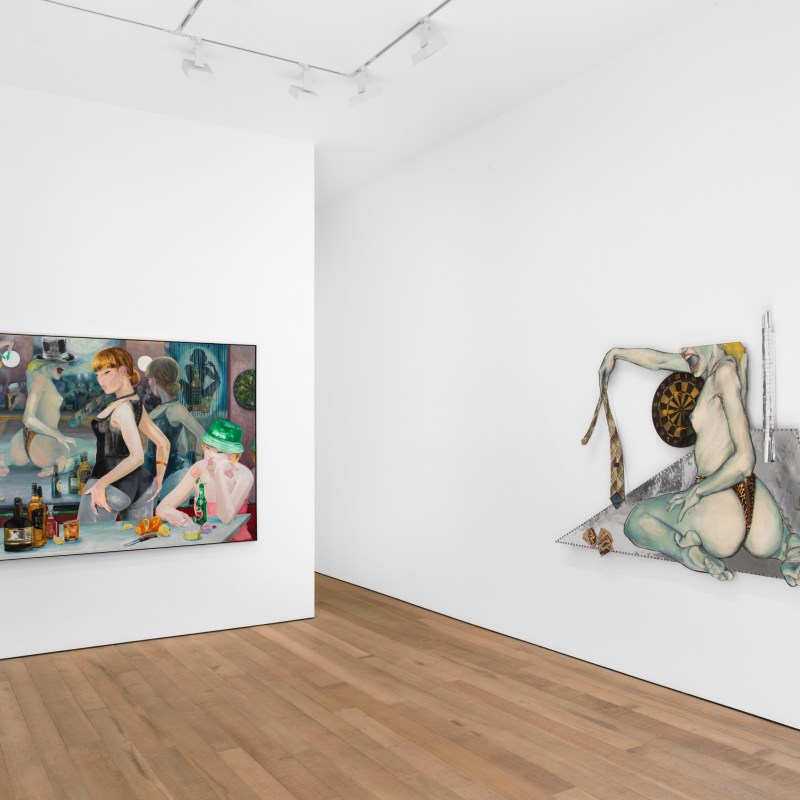Opening in June 2023, Lisa Brice presents two singular works that collectively span her career and recognise her incisive reinterpretations of femininity in culture high or low – marking her first solo exhibition at Sadie Coles HQ and on view at the Bury Street gallery in St James’s.
Since the beginning, Brice has rendered her feminine protagonists as deliberately self-possessed and elusive; continuously redrawing the boundaries of the inner self and outward persona. Her subjects’ identities are repeatedly and purposefully obscured – whether depicted at leisure or working, smoking or painting, nude or clothed – they disrupt the objectifying gaze by eluding fixed interpretation or the imposition of narrative.
Conceived as a focussed presentation, the works’ subject matter reflects Brice’s enduring visual lexicon in which she often layers and subverts references to art historical and contemporary archetypes of femininity. The work made in 1992 is a painted and collaged cut-out portraying a go-go dancer from Brice’s Sex Show Work (1992-1994). This is presented in dialogue with a brand-new painting made in direct response to the original and inspired by Manet’s A Bar at the Folie Bergère, 1882. Both set their compositions in a bar, and the twin works repeat the central figure of a working woman. The more expansive composition of the new painting includes protagonists from Brice’s previous works reimagined as characters in A Bar At The Folies Bergère, mirrored or reversed to reveal an atmosphere wholly feminine. Brice’s interpretation of the Manet bar has beer and champagne replaced by rum and Stag beer and barmaids by dancers, and nods to the Trinidadian context familiar from her After Embah bar scenes from 2017.
In both paintings the protagonists have a double-edged aura of provocative allure, conjuring a critique of traditional objectified femininity and a renewed vision of empowered confrontation. Presenting a timeline simultaneously connects these two works within the gallery, and the earlier painting signposts development from the relatively unknown earlier works of this artist, equally emphasising the conceptual motifs threaded through Brice’s three-decade practice.
The earlier Bar Games, 1992, is a large-scale cut-out composition depicting a scantily dressed dancer on a platform, from a series portraying bar girls or sex workers in performative gestures, their faces explicitly cut off from below the eyes. Within the series, the female subjects are repeated motifs, drawn from the popular men’s magazines of the period such as Penthouse. Made in response to the shaded realm of bar and sex workers and their customers, the series emerged from a broader exploration undertaken by Brice of the sexual objectification of women. Brice noted in Thailand that male customers never made eye contact at sex bars, observing: this would have been an immediate confrontation, causing the girl to become a persona, destroying the sex object illusion.
Through the blunt erasure of their defining facial features and detachment from their surroundings, the bar girls’ overtly sexualised attitudes are reframed with an ominous brutality, drawing to attention the discomfiting reality of their commodification. In this work, the figure is presented as one in a line-up of macho bar props: a tie, a dart board and mirrored pole. Articulated in shades of blue, she turns back seductively toward the onlooker holding out a tie – her partly redacted expression investing the gesture with an ambiguous tone of teasing or derisive mocking.
In Brice’s new painting, she reappropriates the composition from Manet’s renowned scene in A Bar at the Folie Bergère – a source of inspiration to which Brice has returned frequently during her career – reimagined with protagonists from her own past works. Bar Games, 2023, represents her continued practice of revisiting the works of traditionally revered male artists and their impassive female subjects; and equally to the self-possessed subjects of her own. Shown in reverse is the figure opposite from Bar Games, 1992, here placed self-reflexively in dialogue with her earlier self. In the foreground, two subjects mirror those from Brice’s 2017 After Embah series: one a seated figure originally referencing Manet’s Plum Brandy, 1877, and another based on an image of the Trinidadian rapper Nicki Minaj reenvisaged in place of the barmaid.
In Manet’s original – an archetypal example of the male gaze – the barmaid appears as another item available amongst the many consumable offerings, her red breast posy a loaded intimation of the surrounding liquor bottles’ branded labels. In Brice’s version, the carnivalesque mood re-established is in antithesis. The unsettling apathy of the barmaid is supplanted by a figure of poised and provocative self-awareness, whose indifference is directed toward the viewer in an attitude of defiance. From the original mirrored composition, the male patron and throng of spectators are supplanted by an entourage of women who perform for themselves, their painterly features veiled and inscrutable. Through this potent act of erasure, Brice renders a scene of total femininity and displaces the gaze of the onlooker. All that remains are the dartboard, tie and hats (top, sailor and bucket), irreverently paraded by their successors.
Set in juxtaposition, the two works in Bar Games (1992-2023) express the constant pursuit in Brice’s oeuvre to reclaim femininity, from confronting the inherent nature of gender imbalance to a symbol of empowered individualism.
